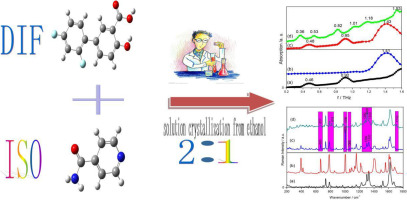Spectrochimica Acta Part A: Molecular and Biomolecular Spectroscopy ( IF 4.3 ) Pub Date : 2019-03-11 , DOI: 10.1016/j.saa.2019.03.023
Yaguo Wang , Jiadan Xue , Qiqi Wang , Shunji Jin , Ziming Zhang , Zhi Hong , Yong Du

|
In order to characterize molecular structure changes of drugs upon co-crystallization by means of spectroscopic techniques, vibrational spectra of solid-state diflunisal (DIF), isonicotinamide (ISO) and their 2:1 co-crystal have been investigated by using terahertz time-domain spectroscopy (THz-TDS) and Raman spectroscopy. A 2:1 DIF-ISO co-crystal between DIF and ISO has been synthesized by slow solution crystallization from ethanol. The experimental THz spectroscopy shows that the co-crystal has a few significantly different absorption peaks compared with raw parent materials within the frequency region from 0.2 to 1.6 THz. Likewise, some differences of vibrational spectra between the co-crystal and starting compounds could also be characterized by Raman spectral results. Density functional theory (DFT) was used to simulate optimized structures and vibrational modes of two kind of possible co-crystal theoretical forms (form I and II) between DIF and ISO. Theoretical co-crystal form I is shown with 2:1 theoretical binary-adduct formed by carboxylic acid-amide and carboxylic acid-pyridine under inter-molecular hydrogen bonding. Theoretical co-crystal form II has a similar structure as form I, meanwhile the only difference is that O63 atom simultaneously forms hydrogen bond with H33 and H64. Also the hydroxyl –OH and carboxyl group –COOH establish molecular heterocycle under intra-molecular hydrogen bonds in both forms. The theoretical results show that both THz and Raman spectra of co-crystal form II between DIF and ISO is more consistent with the experimental observations than those of co-crystal form I. These results provide us with a wealth of information and unique method for characterizing the composition of co-crystal structures and also inter-molecular hydrogen bonding interactions shown within pharmaceutical co-crystallization at the molecular level.
中文翻译:

基于太赫兹和拉曼光谱研究二氟尼醛和异烟酰胺之间2:1共晶体的结构
为了通过光谱技术表征药物在共结晶时的分子结构变化,使用太赫兹时间光谱法研究了固态二氟乙醛(DIF),异烟酰胺(ISO)及其2:1共晶体的振动光谱。域光谱(THz-TDS)和拉曼光谱。DIF和ISO之间的2:1 DIF-ISO共晶体是通过从乙醇中缓慢溶液结晶而合成的。实验的THz光谱表明,与原始母体材料相比,该共晶体在0.2至1.6 THz的频率范围内具有几个明显不同的吸收峰。同样,共晶体和起始化合物之间的振动光谱的一些差异也可以通过拉曼光谱结果来表征。密度泛函理论(DFT)用于模拟DIF和ISO之间两种可能的共晶理论形式(形式I和II)的优化结构和振动模式。示出了理论共晶形式I,其具有在分子间氢键下由羧酸-酰胺和羧酸-吡啶形成的2:1理论二元加合物。理论上的共晶形式II具有与形式I类似的结构,同时唯一的区别是O63原子同时与H33和H64形成氢键。羟基-OH和羧基-COOH还在分子内的氢键下以两种形式建立分子杂环。理论结果表明,DIF和ISO之间的共晶形式II的THz和拉曼光谱均与共晶形式I的更为一致。

































 京公网安备 11010802027423号
京公网安备 11010802027423号